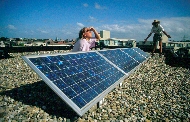

 |
 |
||||||
|
Costs
and benefits of EEG |
meten=weten |
index | |||||
|
|
||||||||
Differenzkosten = EEG-Durchschnittsvergütung – durchschnittliche Strombezugskosten EEG-Umlage = EEG-Quote × Differenzkosten Source:
Beschaffungsmehrkosten für Stromlieferanten durch das |
EEG-Durchschnittsvergütung = average EEG feed-in tariff (total tariffs paid in Euro divided by total kWh feed-in by EEG installations per year).
Durchschnittliche Strombezugskosten = average price for year futures for electricity on Leipzig Electrictiy Stock Exchange (Future Base Year), as of Jan. 1, 2010.
Differenzkosten = difference between above-mentioned components.
EEG-Quote = percentage of EEG electricity to be paid by non-priviliged electricity consumers via their yearly energy bill, in other words: their "obligatory share".
EEG-Umlage = fee per kWh on top of normal/other kWh-related variable costs to be paid by non-priviliged end-users consuming electricity, contributing to cost-recovery of the feed-in tariffs paid to EEG-electricity producers by the local net managers. The amount of money paid by the electricity consumer thus depends on their consumption and could - in theory - help in stimulating him/her extra to use less electricity ("polluter pays principle"). Hence, total fees paid will be higher if consumption is high, and lower if consumption is low. If rational electricity use would indeed be promoted by this mechanism, the financial pressure on big electricity consumers would rise as consumption with more conscious users would diminish, since the Umlage depends on total electricity use.
The fee to be paid in 2010 has been based on prognoses of the development of the electricity consumption and EEG production, and has been fixed at 2,047 Eurocent/kWh (this site). A combination of research institutes (DLR, IWES and IFNE) recently published a study (download from this webpage) in June 2010. In that study a prognosis for 2011 has been made, taking into account strong growth of the photovoltaic market in Germany that probably necessitates a higher Umlage fee for 2010. The difference (expectation: app. 0,3 Eurocent/kWh) will have to be compensated in 2011. For that year, the authors calculated an expected Umlage (including compensation for 2010) of 2,7 Eurocent/kWh excl. VAT. For development of the EEG Umlage in historical terms and with prognosis, see Figure 9.
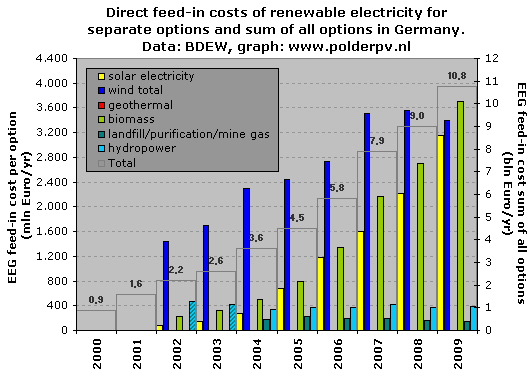
Figure 6. Feed-in costs (amounts of money paid by local net managers to EEG-compliant producers of renewable electricity) per option in 2000-2009 in Germany. Refer to left Y-axis for amounts in million Euro/year for individual options. In gray (broad, translucent columns) total direct EEG feed-in costs are given (right Y-axis, in billion Euro/year, note that this amount is not yet compensated for avoided net costs or other corrections). For 2000-2001 individual cost components were not provided by BDEW. Costs increase strongly for photovoltaics (yellow) and biomass (green), as new capacities are built in large numbers and with increasing average and overall power, cumulating on top of the existing installations. Wind power cost in 2009 had dropped compared to 2008, mainly due to a bad wind year (and start of repowering projects, taking older turbines from the grid).
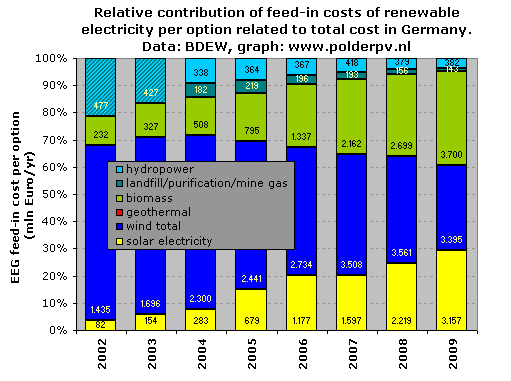
Figure 7. Graph comparable to Fig. 6, excluding the years 2000-2001 (no individual data available). Again (like in Fig. 4), relative shares of each option have been visualized on a 100 percent scale (total cost of all feed-in incentives paid out). Original data have been added for each option in numbers (million Euro/year). The significance of the total fees paid for wind as related to total costs is strongly decreasing, as it is the cheapest renewable electricity option (although volumes are still growing each year). Biomass and photovoltaics have comparable strong impact on total costs, as they grow in volume, and with higher tariff structures for the feed-in. Photovoltaics reached a level of 3,16 billion Euro in 2009, and will grow further considerably in 2010-2011.
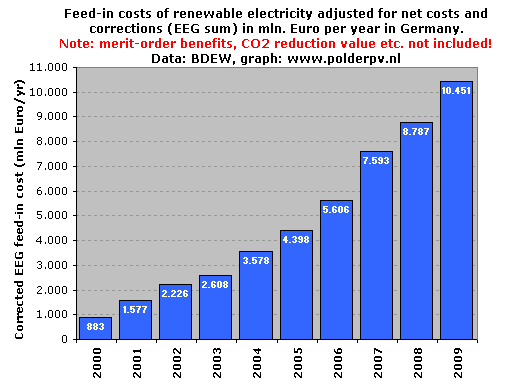
Figure 8. After adjusting for net costs avoided by decentralized production of renewable electricity, and compensating for correction of data in earlier years, total "feed-in costs" are calculated by BDEW, from which the average feed-in tariff can be derived. Total costs increase each year, as Germany succeeds in bringing large volumes of new installations (in particular PV), and healthy growth in the market for - on average - bigger renewable energy installations. Total "cost" has been 10,45 billion Euro in 2009, but one should not forget that this is only one side of the medal. The other, the "net income" side, is much harder to calculate, because of the "free market" mechanisms that have to be taken into account. With volatile market prices for "average electricity" on the Leipziger Strombörse, the politically very sensitive CO2 emission "rights" issues (in particular the price to be paid per tonne), and the uncertain avoided social costs for reducing internal consumption of dwindling, highly problematic, polluting, and ever further monopolized fossil sources. See further below for discussion on the "benefits" of the EEG regime.
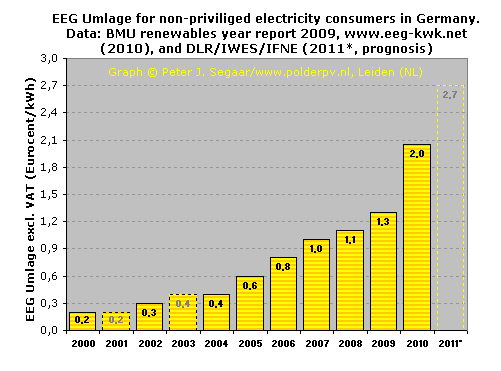
Figure 9. Development of the "EEG Umlage", the fee that all non-priviliged electricity consumers have to pay, as explained in the caption under Fig. 5. I used four sources for this graph. Up till 2009 ("historical development") the BMU report "Erneuerbare Energien in Zahlen. Nationale und internationale Entwicklung" (p. 29), most probably with price corrections (based on 2009 conditions) for earlier years. Since the data for 2001 and 2003 were not given I interpolated the possible "2009 reference" value. Columns for these years have been indicated with a dashed (black) outline.
For 2009, a correction of the earlier stated 1,2 Eurocent/kWh has been given in an August 2010 update by BMU. In that update, for 2009 the Umlage has been fixed at 1,3 Eurocent/kWh. This is 18% higher than the fee in the previous year.
For 2010 I used the present fee fixed by the four big "Übertragungsnetzbetreiber" on the KWK-EEG website, 2,047 Eurocent/kWh (57% higher than the - adjusted - fee in 2009). The prognosis for 2011, 2,7 Eurocent/kWh excl. VAT (dashed open column at the right) comes from an interesting report from a consortium of research institutes under the guidance of Bernd Wenzel and Joachim Nitsch of June 2010 (Institutes involved: DLR's Institut für Technische Thermodynamik, Fraunhofer Institut für Windenergie und Energiesystemtechnik IWES, and Ingenieurbüro für neue Energien, IFNE). Paragraph 4.5 of that report summarizes the expected development of the EEG Umlage. Taking into account the surprising, but policy-driven, very strong market growth of photovoltaics in Germany, the KWK-EEG claim of 2,047 eurocent/kWh for 2010 most probably has been on the low side. This will have to be corrected by the retail companies selling electricity in 2011, and again, strong growth of renewables - in particular PV - will further stimulate increase of the Umlage to be paid by all rate payers in coming years.
Umlage
rising: multiple cause
The
strong rise of the EEG Umlage in 2010 has a threefold cause: (1) collapse
of value of EEG electricity sold on the market (7 to 5,3 Eurocent/kWh,
due to economic world crisis). Because of the lower value of the EEG
electricity in this crisis period, the "difference costs" have
to be paid by the unpriviliged consumers. If market prices will rise
again,
difference will again become smaller, and rate-payers will have to
pay less for the EEG Umlage. (2) Transfer of marketing costs for sale of
EEG
electricity. These were
"hidden"
in
the transportation costs,
and
now are administered under the EEG cost umbrella. The end effect for
consumers (paying less transportation costs, but more for the EEG Umlage)
will be zero,
but the transferred sum (app. 0,4 billion Euro/year) will, of course,
appear as such in the
EEG
"cost" structure. (3) Rising new capacities of renewable
installations, the most "expensive" options PV and biomass
(e.g., fermenters) in particular.
Wenzel and Nitsch also extrapolated further EEG Umlage development, which they expect will follow this trajectory for the "Deutlich" (most aggressive) cost scenario: 2010 2,3 €ct/kWh, 2015 2,7 €ct/kWh, 2020 1,9 €ct/kWh, 2025 1,0 €ct/kWh, and 2030 0,1 €ct/kWh (table 1.1 in pdf).
Protest
against rising Umlage costs
In
an
article by
Roland Schmied of the industrial lobby organisation VIK ("Energie
für
die Industrie") of July 29, 2010, it has been suggested, based
on a "conservative
calculation", that the
Umlage
for 2011 could rise to 3,532 Eurocent/kWh
(suggesting an even higher possible level if
market growth
will be very strong). Details were not given, but even if the 3,5 Eurocent/kWh
will not be reached, further political
turmoil
can be
expected
if
the
Umlage
reaches
levels that VIK considers a threat for its industrial members that
fall out of the "priviliged" class (the latter have to pay
only 0,05 Eurocent/kWh as their "EEG contribution"). VIK claims that
two-third of its "unpriviliged"
members
will bear the
full load that also consumers will have to take. VIK even suggests
a cap on the EEG market ("Deckelung der EEG-Umlage") to stall
rising energy costs for their members. But such a drastic measure
will spell disaster for market conditions for, in particular, the most "expensive"
renewable options such as PV (capping of the Umlage almost certainly
implies capping new capacity volumes accepted, or non-economic feed-in
tariffs
for
PV). What VIK forgets, of course, is that their members
pay a much lower price
for
electricity
than private consumers, and that market prices have collapsed due to
the economic crises. In addition, that "market price" is
pushed downward, just because of the huge volumes
of renewable
electricity
obligatory
traded by the four biggest net managers on the Leipziger Strombörse.
Even negative prices are becoming apparent on some very windy days
(on those days, in theory, VIK members could join a free ride with
electricity for a bargain). As capacities are increased
further, the damping effect
of renewables
on market prices will
benefit
to all
electricity
consumers. Even solar electricity, just 1-2 percent of total electricity
consumption in Germany, has shown starting to shave midday
consumption peaks at Leipzig's EEX electricity exchange. Graphs were
shown implying smoothing of costs and preventing starting up of expensive
peak-load facilities (article in Photon, august 2010: pp. 22-29, "Photovoltaik
stellt die Systemfrage"). In the end, part of the socialized EEG feed-in
costs to be paid by VIK members could, of course, be earned back by
installing
a PV-system
on the mostly large roofs of their premises under present-day, still
interesting EEG conditions.
Renewables
are not the biggest kWh price driver
What
many critics of the "cost" structure of the EEG also forget is
that, although the fee to be paid still is rising, the biggest cost driver
for the
kWh price remains the costs of production, transport and marketing
of electricity from centralized fossil and nuclear sources, as revealed
by the yearly publication
of
the EEG developments by the Environment Ministry, BMU for household
customers:
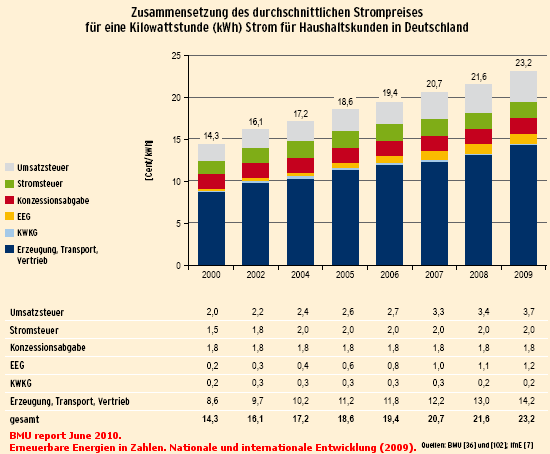 |
^^^ © 2010 BMU |
In the report worked out by Wenzel & Nitsch (2010) it is further emphasized that, due to an expected maximum of the "EEG-Differenzkosten" in the years 2015-2016, the ultimate EEG-Umlage for non-priviliged customers would sink again, reaching a predicted maximum of around 3 Eurocent/kWh (excl. VAT) in those years. The authors claim that in coming years the "EEG cost zenith" will be reached, but that photovoltaics will dominate the total costs of EEG. For a household using 3.500 kWh/year, the monthly contribution to the incentives for the world market in photovoltaics would rise to a maximum of approximately 3 Euro/month (ex VAT) in the strong development "Deutlich" case (in the years 2015-2016, sinking afterwards, for impact of the whole EEG Umlage, see table below). That would amount to a per household contribution of approximately 36 Euro a year to the decentralized photovoltaics revolution applicable to millions of sites. Less if that household will limit its yearly consumption, which in many cases is within reach (the webmaster of Polder PV used only 1.200 kWh/year for a long time in a household of two persons). Of course, these data will be influenced if the photovoltaics boom continues, with new capacities probably much larger that predicted in these scenario's (W. & N. estimate 6 GWp for photovoltaics in 2010, it could turn out to be considerably more, with already 3,4 GWp realized in the first half year, according to Bundesnetzagentur).
Finally, also calculation examples for the yearly costs are given for two price development scenario's. For the "high price" ("Deutlich") scenario the table from the Wenzel & Nitsch study is given below:
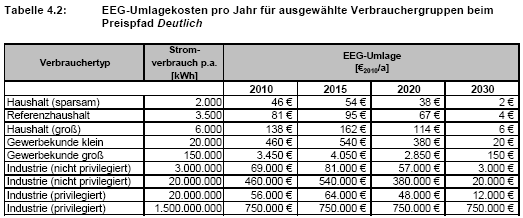 |
^^^ © Wenzel & Nitsch (2010), see this document published June 2010 |
Merit
order drives market price down - by renewables (BMU report
2009,
page 29). As explained in increasing detail, BMU has stressed that apart
from the intensively
debated
"cost" side of the EEG, there are also many benefits that should
be taken into consideration for a fair and balanced discussion on its impact
on
society. One of these benefits is the so-called "merit-order effect",
resulting from the mechanism
of
decreasing
market
prices as a
result of
obligatory sale of large volumes of renewable electricity having no fuel
costs. Therefore, renewables like wind are already off-setting the most
expensive final contributers to the spot-price mix, resulting in a lower
spot-price on the market. Depending on the contract conditions, customers
most likely will profit from that lower market price. BMU has planned
to monitor the effects in increasing detail, and their first revelations
have
been
published in this table in their 2009 year report:
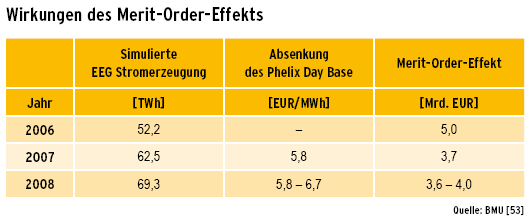
The table shows that the merit-order effect could have resulted in profits for society amounting to 5 billion Euro in 2006, 3,7 billion Euro in 2007, and 3,6-4,0 billion Euro in 2008.
Other
benefits
Of course there are many other benefits for society, such as jobs
(for photovoltaics many thousands in the installation sector*),
avoiding expensive social unemployment fees to be paid, generating
income
tax, keeping an increasing amount of the staggering fossil-fuel based
money transfers "normally" leaking away in the region,
thereby increasing social-economic stability, eroding the dangerous
dependencies on
foreign and/or further strongly monopolizing
fossil and
nuclear energy conglomerates, democratizing national energy production,
cleaning up the environment, re-using large stretches of contaminated
or wasted "fossil fuel sites" like big lignite mines and
polluted former power plant sites (large PV power plants possible
on these
premises), cleaner
air, more self-responsibility, etc.
Many
of these positive impacts, hard to calculate in a precise manner,
will also have indirect, but massive impact on monetary relations.
Because
more
money will
be invested in hardware producing healthy and dark green energy for
many years to come, instead of in immense, not physically-backed
air-balloons
like
those that brought
the financial
sector on the brink of collapse. Another highly questionable "balloon"
being the very misty "trade" in CO2 emission "rights", fraude-generating
"clean development mechanisms", double booking of "green" certificates,
and the like...
* Jobs according to year report BMU (p. 27): 300.500 in renewable energy, 8% increase in crisis year 2009 as compared to 2008. Solar energy including photovoltaics: increase of 74.400 (2008) up till 79.600 in 2009 (almost 7% increase in a year).
One of the most promising direct effects is that preliminary calculations by BMU resulted in avoided costs of 70 Euro per tonne CO2. One of the studies commanded by BMU came up with a total of 7,8 billion Euro avoided costs for the environment for a combination of renewable electricity (5,7 billion Euro) and heat (2,1 billion Euro). Taking into account the (avoided) costs for CO2 certificates and partial internalisation of costs for the environment, still 4,8 billion Euro would remain as positive effect for renewable electricity, and 2,0 billion Euro for renewable heat. Again: these large benefits should be taken into account when considering "costs and benefit calculations" of total EEG impact (and other regimes stimulating renewables). BMU will further analyse detail effects in coming years.
If we would only take the average merit-order effect of the three years shown in the table above, app. 4,2 billion Euro, and the above-mentioned remaining 4,8 billion Euro for avoided environment costs by renewable electricity, already 9 billion Euro should be put on the other side of the "10,5 billion Euro cost scale" (Fig. 8) for EEG feed-in billed to the rate-payers. Hence, these two benefit posts compensate for the biggest part of what some critics suggest would be a waste of money if they write about the impact of the EEG (only stressing "costs").
In addition avoided CO2 emission costs for all options in Germany (renewable electricity, heat, and motor fuels) would bring another app. gross 7,4 billion Euro as "profit" (before internalisation of CO2 costs) as "vermiedene Klimaschäden" for the 107 million tonnes of CO2 avoided by renewables in 2009.
For further reading and two interesting "climate costs graphs per option", see pp. 33-34 of the 2009 study by BMU. In the report extensive details are given for the impact of all renewables in that year.
Further
results of the "all-renewable" package deal of Germany
The
EEG is not the only Law or measure that has made Germany the world
market for succesfull implementation and strong growth of renewables.
A summary of some of the highlights of the 2009 year report is given
here. Please, be aware of the fact that these are data for one of
the most heavily industrialized nations on Earth...:
Bundesverband der Energie- und Wasserwirtschaft (BDEW, data source for most graphs presented on this page)
http://www.erneuerbare-energien.de/inhalt/2720/5466/ (comprehensive
state of knowledge of effects of German EEG in the 2009 year report, "Erneuerbare
Energien in Zahlen - nationale und internationale Entwicklung"; several
other fascinating documents, and full-spreadsheet with summary of all relevant
details. Unparalleled "Deutsch-Grundlich").
http://www.erneuerbare-energien.de/inhalt/45026/main/ (page
from which the Wenzel/Nitsch study of June 2010 can be downloaded)
http://www.erneuerbare-energien.de/inhalt/46260/4590/ (future
of German EEG analyzed with reference to strongly changed market conditions
and cost development, BMU, juni 2010)
http://www.erneuerbare-energien.de/inhalt/43981/ (questions
and answers pertaining to German's EEG Law)
http://www.erneuerbare-energien.de/inhalt/45911/43981/ ("six
critical questions about and misinterpretations of the German EEG
regime")
http://www.erneuerbare-energien.de/inhalt/46348/4613/ (adapted
EEG 2010 Novelle dated August 11, 2010, including strong extra degression
steps as of July 1, 2010, and exclusion of new free field PV-installations
from the EEG Law as of that date)
http://www.unendlich-viel-energie.de/de/solarenergie/detailansicht/article/36/foerderung-fuer-oekoenergien-kosten-und-nutzen-transparent-machen.html (11 oktober 2010: "Förderung für Ökoenergien: „Kosten und Nutzen transparent machen“" - Study of Wuppertal Institut in abstract. Watch the included graph!!!)
http://www.unendlich-viel-energie.de/de/solarenergie/detailansicht/article/39/grafik-dossier-stromkosten-privater-haushalte.html (electricity costs for German households - all aspects in graphs and informative notes and lots of very interesting links)
Webpage
published August
30, 2010. Updates: September 1, 2010 (EEG Umlage 2009 by BMU); December
9, 2010 (Abstract link Wuppertal Institute study, electricity costs
German households link)
|